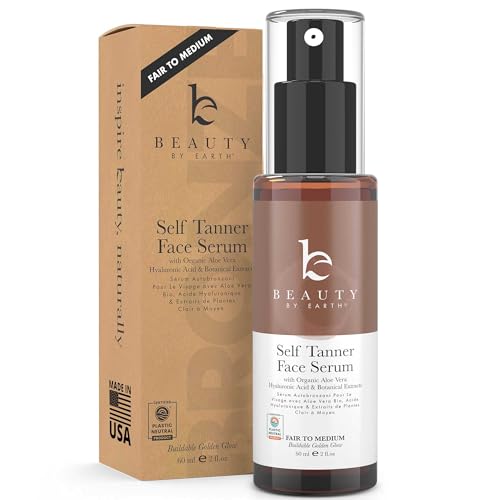
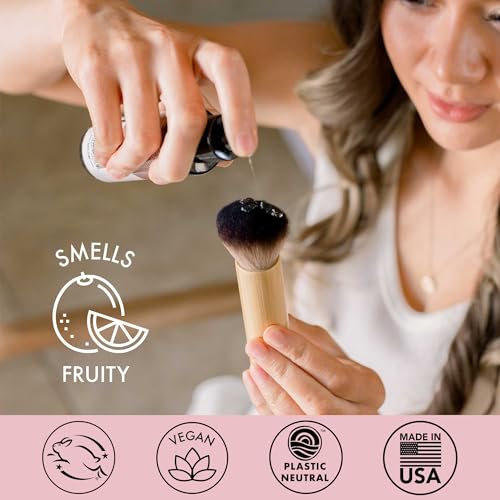
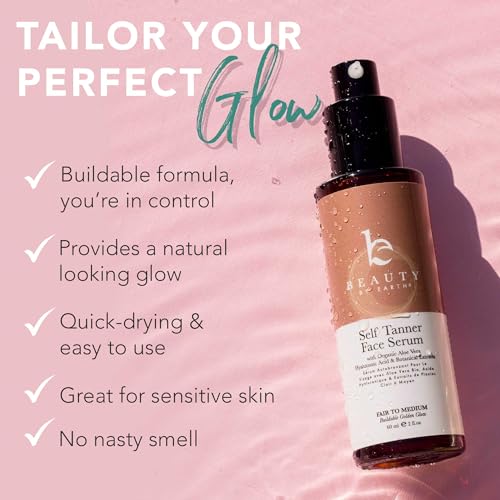
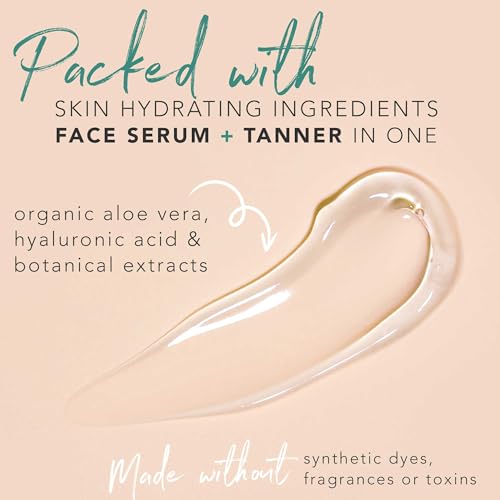
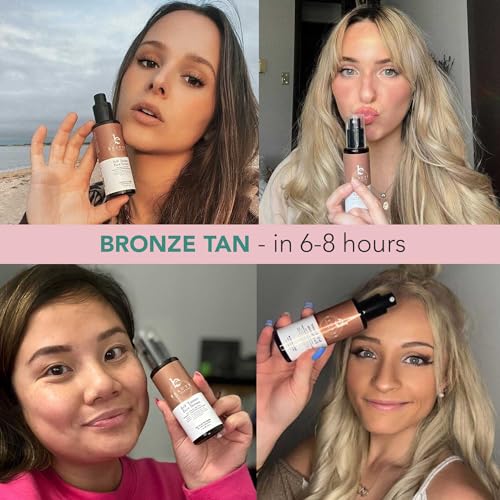
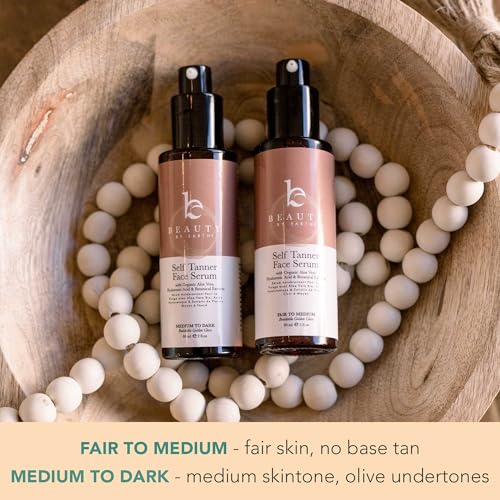
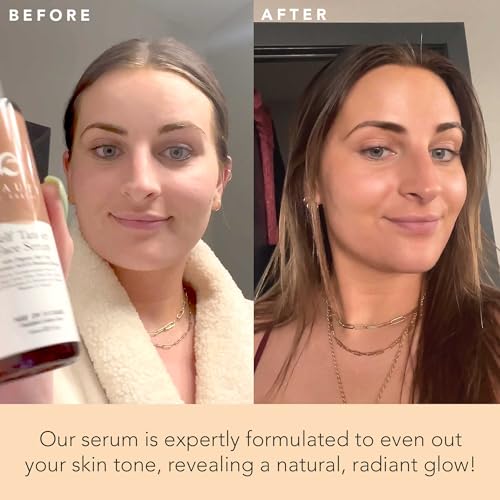
Beauty by Earth Face Tanner Serum - Anti-Aging Hydration, Quick Drying Formula - 1.7oz


Dihydroxyacetone
High RiskDihydroxyacetone is an aliphatic ketone commonly used as a color additive in cosmetics, particularly in self-tanning products. It reacts with amino acids in the skin to produce a temporary brown color, mimicking a tan without exposure to UV radiation.
Sustai Insights
Dihydroxyacetone offers functional benefits as a skin-tanning agent without UV exposure, making it a safer alternative for achieving a bronzed appearance. However, it carries high use restrictions and is associated with low health risks such as irritation. Environmental concerns include its potential to contribute to pollution, while regulatory bodies may issue warnings regarding its use. Overall, the ingredient presents a high risk, necessitating careful consideration of usage practices and potential alternatives.
Camellia Sinensis (Green Tea) Extract
Medium RiskCamellia sinensis (green tea) extract is derived from the leaves of the Camellia sinensis plant, commonly used in cosmetics and personal care products for its antioxidant properties. It serves as a skin conditioning agent and can provide a soothing effect due to its natural compounds.
Sustai Insights
Green tea extract offers functional benefits such as antioxidant properties that may protect skin from oxidative stress. However, it poses moderate allergenic potential and should be used cautiously by sensitive individuals. Environmentally, it is considered low risk, with no significant bioaccumulation or pollution concerns. Regulatory bodies have not imposed severe restrictions, but users should maintain safe application practices. Overall, the ingredient presents a medium risk profile due to its potential health and environmental impacts.
Citrus Grandis (Grapefruit) Peel Oil
Medium RiskCitrus grandis (grapefruit) peel oil is a volatile essential oil extracted from the peel of grapefruit. It is commonly used for its aromatic properties and as a flavoring agent in various products such as cosmetics and food. Its composition includes compounds like limonene and citral.
Sustai Insights
Citrus grandis (grapefruit) peel oil offers functional benefits such as fragrance enhancement and potential skin conditioning properties. However, it is associated with a high risk of allergic reactions and may enhance skin absorption of other substances. Regulatory restrictions apply, particularly regarding its use in products containing certain chemicals. Environmental concerns include its potential as a pollutant. Overall, it poses a medium risk, necessitating caution during use, especially for sensitive populations. Alternatives may include oils from less allergenic sources.
Citrus Aurantium Dulcis (Orange) Oil
Medium RiskCitrus aurantium dulcis (orange) oil is a volatile oil extracted from the fresh peel of oranges. It is commonly used in cosmetic and personal care products for its fragrance and potential skin benefits.
Sustai Insights
Citrus aurantium dulcis (orange) oil offers functional benefits as a natural fragrance and may provide skin conditioning effects. However, it has a high allergenic potential, posing risks of skin irritation and allergic reactions. Environmental concerns include moderate persistence and potential bioaccumulation. Regulatory bodies may impose usage restrictions, indicating a medium overall risk level. For safe use, it's advisable to patch test and consider alternatives like other citrus oils or synthetic fragrances to mitigate allergy risks.
Glycerin
Medium RiskGlycerin (also called glycerol) is a naturally occurring compound commonly used in personal care and cosmetic products. It functions as a humectant, attracting moisture to the skin, and is also utilized as a solvent and emollient to enhance product texture and stability.
Sustai Insights
Glycerin is valued for its effective moisturizing properties and biodegradability, making it a widely accepted ingredient in formulations. It poses low health risks, including low concerns for carcinogenicity and allergies. However, moderate use restrictions exist due to regulatory guidelines. While glycerin does not significantly contribute to environmental pollution, its production process should be ethically sourced. Overall, glycerin holds a medium risk level, emphasizing the importance of safe usage practices and considering sustainable alternatives.
Punica Granatum (Pomegranate) Extract
Low RiskPunica granatum (pomegranate) extract is derived from the fruit of the pomegranate. It is commonly used in cosmetic formulations for its antioxidant properties and is believed to support skin health.
Sustai Insights
Pomegranate extract offers functional benefits such as antioxidant protection and skin conditioning. It is considered low risk regarding health concerns, with minimal potential for carcinogenicity, allergies, and reproductive toxicity. Environmental impact appears low, with no significant pollutant or bioaccumulation potential. Regulatory bodies do not impose restrictions on its use. Safe usage practices should be followed, though no significant alternatives are noted. Overall, the ingredient is assessed as low risk.
Zingiber Officinale (Ginger) Root Extract
Low RiskZingiber officinale (ginger) root extract is derived from the ginger plant, widely recognized for its use in culinary applications and traditional medicine. It serves various functions in products, including flavor enhancement and potential therapeutic benefits due to its bioactive compounds.
Sustai Insights
Ginger root extract offers functional benefits such as flavoring and possible anti-inflammatory properties. It is sustainably sourced and biodegradable. Health risks are low, with minimal concerns regarding carcinogenicity, allergies, or reproductive toxicity. Environmental risks appear low, with no significant pollutants. Regulatory status is favorable, with no major warnings. Overall, the risk level associated with ginger root extract is low, making it a suitable ingredient in various applications.
Hamamelis Virginiana (Witch Hazel) Extract
Low RiskHamamelis virginiana (witch hazel) extract is derived from the bark and leaves of the witch hazel plant. It is commonly used in cosmetic products for its astringent properties, helping to tighten skin and reduce irritation. The extract is recognized for its soothing effects on the skin.
Sustai Insights
Witch hazel extract provides functional benefits as an astringent, helping to minimize skin irritation and enhance skin appearance. It is generally considered low risk for health concerns, with minimal evidence of carcinogenicity, allergenic potential, or reproductive toxicity. Environmental impact is also low, as it does not significantly contribute to pollution or bioaccumulation. Regulatory bodies have not issued major warnings, supporting its safety for use in cosmetics. For safe usage, it is recommended to avoid contact with eyes and to use in appropriate concentrations. Overall, it is regarded as a low-risk ingredient.
Hyaluronic Acid
Low RiskHyaluronic acid is a natural polysaccharide found in connective tissues, skin, and cartilage, primarily serving as a moisture-retaining agent in cosmetic products. Its primary function is to provide hydration and improve skin elasticity, making it a common ingredient in moisturizers and serums.
Sustai Insights
Hyaluronic acid offers significant functional benefits, such as effective hydration and skin plumping, while being biodegradable and generally recognized as safe by regulatory bodies. Health risks are minimal, with low concerns regarding carcinogenicity, allergies, or reproductive toxicity. Environmental risks are also low, as it is not considered a pollutant or bioaccumulative. Regulatory bodies have not issued major advisories against its use, resulting in an overall low-risk assessment. For safe usage, it is recommended to apply in appropriate concentrations. Alternatives include glycerin or aloe vera, which also provide hydration.
Leuconostoc/Radish Root Ferment Filtrate
Low RiskLeuconostoc/radish root ferment filtrate is a natural fermentation product derived from radish roots, commonly used in skincare for its potential preservative properties and skin-conditioning benefits. It functions by harnessing the metabolic activity of Leuconostoc bacteria to provide a source of beneficial compounds.
Sustai Insights
This ingredient offers functional benefits, primarily as a preservative and skin-conditioning agent, while being biodegradable and sustainably sourced. Health risks are generally low, with no significant concerns regarding carcinogenicity or allergies, though contamination concerns exist. Environmentally, it poses minimal risks, categorized as low overall risk based on current scientific consensus. Safe usage practices are advised, and alternatives may include other natural preservatives like tocopherol or rosemary extract.
Chamomilla Recutita (Matricaria) Flower Extract
Low RiskChamomilla recutita (Matricaria) flower extract is derived from the flower of the chamomile plant. It is commonly used in cosmetic products for its soothing properties and as an anti-inflammatory agent. This extract is valued for its potential to calm skin irritations and enhance overall skin appearance.
Sustai Insights
Chamomilla recutita (Matricaria) flower extract is recognized for its soothing and anti-inflammatory benefits, making it effective in skincare formulations. It is sustainably sourced and not associated with significant health risks, such as carcinogenicity or allergenic potential, resulting in a low-risk profile. Environmental concerns are minimal as it does not contribute significantly to pollution. Regulatory bodies impose few restrictions on its use, further supporting its safety. However, users should practice standard safety measures, particularly if they have known sensitivities. Overall, it is a low-risk ingredient with favorable attributes.
Vanilla Tahitensis Fruit Extract
Low RiskVanilla tahitensis fruit extract is an extract derived from the fruit of the Tahitian vanilla plant, primarily used for its aromatic properties in cosmetic formulations. It serves as a fragrance component and may also provide some antioxidant benefits in skin care products.
Sustai Insights
Vanilla tahitensis fruit extract offers functional benefits as a natural fragrance agent and may have mild antioxidant properties. The ingredient is associated with low health risks, including negligible potential for cancer, allergies, or reproductive toxicity. Environmentally, it poses low risks and is not known to be bioaccumulative. Regulatory assessments indicate no significant concerns. Overall, the ingredient is considered low risk, with safe usage practices likely leading to positive consumer experiences.
Calendula Officinalis (Pot Marigold) Flower Extract
Low RiskExtract of the Calendula (Calendula officinalis) flower, commonly known as pot marigold, is utilized in cosmetic formulations for its soothing and anti-inflammatory properties. It is often included in creams, lotions, and ointments to promote skin health and healing.
Sustai Insights
Calendula officinalis flower extract offers functional benefits such as skin soothing and anti-inflammatory effects, making it valuable in topical applications. It is considered low risk for health impacts, with minimal concerns regarding carcinogenicity, allergies, or reproductive toxicity. Environmentally, it presents low pollution potential and is not bioaccumulative. Regulatory bodies have not imposed significant restrictions. Safe usage practices should be followed, and while alternatives exist, this extract is generally regarded as a low-risk option for cosmetic use.
Xanthan Gum
Low RiskXanthan gum is a polysaccharide, a sugar-based compound produced by the fermentation of glucose or sucrose. It is commonly used as a thickening agent and stabilizer in various food and cosmetic products due to its ability to improve texture and prevent ingredient separation.
Sustai Insights
Xanthan gum serves effectively as a thickener and stabilizer, enhancing product texture and consistency. It is biodegradable and typically derived from renewable sources, supporting sustainability efforts. Health risks are minimal, with low concerns regarding carcinogenicity, allergies, and reproductive toxicity. Environmental impact is similarly low, posing no significant hazards. Regulatory agencies, including the FDA, regard it as safe for use, with no significant restrictions. Overall, xanthan gum is assessed as low risk, making it a suitable ingredient in formulations.
Aloe Barbadensis (Aloe Vera) Leaf Juice
Low RiskAloe barbadensis (aloe vera) leaf juice is derived from the succulent aloe vera plant, known for its hydrating and soothing properties. It is commonly used in cosmetic formulations for its moisturizing effects and is often included in products aimed at skin care and healing.
Sustai Insights
Aloe vera leaf juice offers functional benefits as a moisturizer and skin soothing agent, while being sustainably sourced and biodegradable. Health risks are low, with minimal concerns regarding carcinogenicity, allergies, and reproductive toxicity. Environmental impact is also low, with no significant pollutants identified. Regulatory agencies impose few restrictions. Overall, the ingredient poses a low risk, making it a favorable choice in cosmetic formulations.
Punica Granatum (Pomegranate) Extract
Low RiskPunica granatum (pomegranate) extract is derived from the fruit of the pomegranate. It is commonly used in cosmetic formulations for its antioxidant properties and is believed to support skin health.
Sustai Insights
Pomegranate extract offers functional benefits such as antioxidant protection and skin conditioning. It is considered low risk regarding health concerns, with minimal potential for carcinogenicity, allergies, and reproductive toxicity. Environmental impact appears low, with no significant pollutant or bioaccumulation potential. Regulatory bodies do not impose restrictions on its use. Safe usage practices should be followed, though no significant alternatives are noted. Overall, the ingredient is assessed as low risk.
Zingiber Officinale (Ginger) Root Extract
Low RiskZingiber officinale (ginger) root extract is derived from the ginger plant, widely recognized for its use in culinary applications and traditional medicine. It serves various functions in products, including flavor enhancement and potential therapeutic benefits due to its bioactive compounds.
Sustai Insights
Ginger root extract offers functional benefits such as flavoring and possible anti-inflammatory properties. It is sustainably sourced and biodegradable. Health risks are low, with minimal concerns regarding carcinogenicity, allergies, or reproductive toxicity. Environmental risks appear low, with no significant pollutants. Regulatory status is favorable, with no major warnings. Overall, the risk level associated with ginger root extract is low, making it a suitable ingredient in various applications.
Camellia Sinensis (Green Tea) Extract
Medium RiskCamellia sinensis (green tea) extract is derived from the leaves of the Camellia sinensis plant, commonly used in cosmetics and personal care products for its antioxidant properties. It serves as a skin conditioning agent and can provide a soothing effect due to its natural compounds.
Sustai Insights
Green tea extract offers functional benefits such as antioxidant properties that may protect skin from oxidative stress. However, it poses moderate allergenic potential and should be used cautiously by sensitive individuals. Environmentally, it is considered low risk, with no significant bioaccumulation or pollution concerns. Regulatory bodies have not imposed severe restrictions, but users should maintain safe application practices. Overall, the ingredient presents a medium risk profile due to its potential health and environmental impacts.
Hamamelis Virginiana (Witch Hazel) Extract
Low RiskHamamelis virginiana (witch hazel) extract is derived from the bark and leaves of the witch hazel plant. It is commonly used in cosmetic products for its astringent properties, helping to tighten skin and reduce irritation. The extract is recognized for its soothing effects on the skin.
Sustai Insights
Witch hazel extract provides functional benefits as an astringent, helping to minimize skin irritation and enhance skin appearance. It is generally considered low risk for health concerns, with minimal evidence of carcinogenicity, allergenic potential, or reproductive toxicity. Environmental impact is also low, as it does not significantly contribute to pollution or bioaccumulation. Regulatory bodies have not issued major warnings, supporting its safety for use in cosmetics. For safe usage, it is recommended to avoid contact with eyes and to use in appropriate concentrations. Overall, it is regarded as a low-risk ingredient.
Citrus Grandis (Grapefruit) Peel Oil
Medium RiskCitrus grandis (grapefruit) peel oil is a volatile essential oil extracted from the peel of grapefruit. It is commonly used for its aromatic properties and as a flavoring agent in various products such as cosmetics and food. Its composition includes compounds like limonene and citral.
Sustai Insights
Citrus grandis (grapefruit) peel oil offers functional benefits such as fragrance enhancement and potential skin conditioning properties. However, it is associated with a high risk of allergic reactions and may enhance skin absorption of other substances. Regulatory restrictions apply, particularly regarding its use in products containing certain chemicals. Environmental concerns include its potential as a pollutant. Overall, it poses a medium risk, necessitating caution during use, especially for sensitive populations. Alternatives may include oils from less allergenic sources.
Citrus Aurantium Dulcis (Orange) Oil
Medium RiskCitrus aurantium dulcis (orange) oil is a volatile oil extracted from the fresh peel of oranges. It is commonly used in cosmetic and personal care products for its fragrance and potential skin benefits.
Sustai Insights
Citrus aurantium dulcis (orange) oil offers functional benefits as a natural fragrance and may provide skin conditioning effects. However, it has a high allergenic potential, posing risks of skin irritation and allergic reactions. Environmental concerns include moderate persistence and potential bioaccumulation. Regulatory bodies may impose usage restrictions, indicating a medium overall risk level. For safe use, it's advisable to patch test and consider alternatives like other citrus oils or synthetic fragrances to mitigate allergy risks.
Hyaluronic Acid
Low RiskHyaluronic acid is a natural polysaccharide found in connective tissues, skin, and cartilage, primarily serving as a moisture-retaining agent in cosmetic products. Its primary function is to provide hydration and improve skin elasticity, making it a common ingredient in moisturizers and serums.
Sustai Insights
Hyaluronic acid offers significant functional benefits, such as effective hydration and skin plumping, while being biodegradable and generally recognized as safe by regulatory bodies. Health risks are minimal, with low concerns regarding carcinogenicity, allergies, or reproductive toxicity. Environmental risks are also low, as it is not considered a pollutant or bioaccumulative. Regulatory bodies have not issued major advisories against its use, resulting in an overall low-risk assessment. For safe usage, it is recommended to apply in appropriate concentrations. Alternatives include glycerin or aloe vera, which also provide hydration.
Leuconostoc/Radish Root Ferment Filtrate
Low RiskLeuconostoc/radish root ferment filtrate is a natural fermentation product derived from radish roots, commonly used in skincare for its potential preservative properties and skin-conditioning benefits. It functions by harnessing the metabolic activity of Leuconostoc bacteria to provide a source of beneficial compounds.
Sustai Insights
This ingredient offers functional benefits, primarily as a preservative and skin-conditioning agent, while being biodegradable and sustainably sourced. Health risks are generally low, with no significant concerns regarding carcinogenicity or allergies, though contamination concerns exist. Environmentally, it poses minimal risks, categorized as low overall risk based on current scientific consensus. Safe usage practices are advised, and alternatives may include other natural preservatives like tocopherol or rosemary extract.
Chamomilla Recutita (Matricaria) Flower Extract
Low RiskChamomilla recutita (Matricaria) flower extract is derived from the flower of the chamomile plant. It is commonly used in cosmetic products for its soothing properties and as an anti-inflammatory agent. This extract is valued for its potential to calm skin irritations and enhance overall skin appearance.
Sustai Insights
Chamomilla recutita (Matricaria) flower extract is recognized for its soothing and anti-inflammatory benefits, making it effective in skincare formulations. It is sustainably sourced and not associated with significant health risks, such as carcinogenicity or allergenic potential, resulting in a low-risk profile. Environmental concerns are minimal as it does not contribute significantly to pollution. Regulatory bodies impose few restrictions on its use, further supporting its safety. However, users should practice standard safety measures, particularly if they have known sensitivities. Overall, it is a low-risk ingredient with favorable attributes.
Vanilla Tahitensis Fruit Extract
Low RiskVanilla tahitensis fruit extract is an extract derived from the fruit of the Tahitian vanilla plant, primarily used for its aromatic properties in cosmetic formulations. It serves as a fragrance component and may also provide some antioxidant benefits in skin care products.
Sustai Insights
Vanilla tahitensis fruit extract offers functional benefits as a natural fragrance agent and may have mild antioxidant properties. The ingredient is associated with low health risks, including negligible potential for cancer, allergies, or reproductive toxicity. Environmentally, it poses low risks and is not known to be bioaccumulative. Regulatory assessments indicate no significant concerns. Overall, the ingredient is considered low risk, with safe usage practices likely leading to positive consumer experiences.
Dihydroxyacetone
High RiskDihydroxyacetone is an aliphatic ketone commonly used as a color additive in cosmetics, particularly in self-tanning products. It reacts with amino acids in the skin to produce a temporary brown color, mimicking a tan without exposure to UV radiation.
Sustai Insights
Dihydroxyacetone offers functional benefits as a skin-tanning agent without UV exposure, making it a safer alternative for achieving a bronzed appearance. However, it carries high use restrictions and is associated with low health risks such as irritation. Environmental concerns include its potential to contribute to pollution, while regulatory bodies may issue warnings regarding its use. Overall, the ingredient presents a high risk, necessitating careful consideration of usage practices and potential alternatives.
Calendula Officinalis (Pot Marigold) Flower Extract
Low RiskExtract of the Calendula (Calendula officinalis) flower, commonly known as pot marigold, is utilized in cosmetic formulations for its soothing and anti-inflammatory properties. It is often included in creams, lotions, and ointments to promote skin health and healing.
Sustai Insights
Calendula officinalis flower extract offers functional benefits such as skin soothing and anti-inflammatory effects, making it valuable in topical applications. It is considered low risk for health impacts, with minimal concerns regarding carcinogenicity, allergies, or reproductive toxicity. Environmentally, it presents low pollution potential and is not bioaccumulative. Regulatory bodies have not imposed significant restrictions. Safe usage practices should be followed, and while alternatives exist, this extract is generally regarded as a low-risk option for cosmetic use.
Glycerin
Medium RiskGlycerin (also called glycerol) is a naturally occurring compound commonly used in personal care and cosmetic products. It functions as a humectant, attracting moisture to the skin, and is also utilized as a solvent and emollient to enhance product texture and stability.
Sustai Insights
Glycerin is valued for its effective moisturizing properties and biodegradability, making it a widely accepted ingredient in formulations. It poses low health risks, including low concerns for carcinogenicity and allergies. However, moderate use restrictions exist due to regulatory guidelines. While glycerin does not significantly contribute to environmental pollution, its production process should be ethically sourced. Overall, glycerin holds a medium risk level, emphasizing the importance of safe usage practices and considering sustainable alternatives.
Xanthan Gum
Low RiskXanthan gum is a polysaccharide, a sugar-based compound produced by the fermentation of glucose or sucrose. It is commonly used as a thickening agent and stabilizer in various food and cosmetic products due to its ability to improve texture and prevent ingredient separation.
Sustai Insights
Xanthan gum serves effectively as a thickener and stabilizer, enhancing product texture and consistency. It is biodegradable and typically derived from renewable sources, supporting sustainability efforts. Health risks are minimal, with low concerns regarding carcinogenicity, allergies, and reproductive toxicity. Environmental impact is similarly low, posing no significant hazards. Regulatory agencies, including the FDA, regard it as safe for use, with no significant restrictions. Overall, xanthan gum is assessed as low risk, making it a suitable ingredient in formulations.
Aloe Barbadensis (Aloe Vera) Leaf Juice
Low RiskAloe barbadensis (aloe vera) leaf juice is derived from the succulent aloe vera plant, known for its hydrating and soothing properties. It is commonly used in cosmetic formulations for its moisturizing effects and is often included in products aimed at skin care and healing.
Sustai Insights
Aloe vera leaf juice offers functional benefits as a moisturizer and skin soothing agent, while being sustainably sourced and biodegradable. Health risks are low, with minimal concerns regarding carcinogenicity, allergies, and reproductive toxicity. Environmental impact is also low, with no significant pollutants identified. Regulatory agencies impose few restrictions. Overall, the ingredient poses a low risk, making it a favorable choice in cosmetic formulations.
Discover the Face Tanner Serum, a revolutionary sunless tanner designed for your face, infused with hyaluronic acid for hydration and anti-aging benefits. This natural self-tanner provides a radiant glow while ensuring clean, powerful ingredients for your skin's health.
- Dual Action Formula: Combines self-tanning and anti-aging properties, giving you a youthful glow while enhancing your complexion.
- Quick-Drying Application: Dries in just 5-10 minutes, allowing you to seamlessly integrate it into your skincare routine.
- Versatile Shade Options: Available in Fair to Medium and Medium to Dark, ensuring a natural tan without orange tones for all skin types.
- Organic Ingredients: Formulated with certified organic ingredients like aloe vera and chamomile, promoting skin health and sustainability.
- Customer Satisfaction Guarantee: Backed by positive reviews and a commitment to quality, ensuring a pleasant experience for every user.
Subscribe & Save with Sustai
- Best Price Guarantee: Always enjoy the lowest prices on sustainable home essentials.
- No Surprises: We’ll notify you before shipping. No hidden fees, ever.
- You’re in Charge: Change, pause, or cancel your subscription anytime with ease.
- Eco-Friendly Deliveries: Our grouped shipments mean less packaging and lower emissions.
Join us on a sustainable journey. Special offers for a limited time! Prices and promotions may change.
Recommended Products
Discover the Face Tanner Serum, a revolutionary sunless tanner designed for your face, infused with hyaluronic acid for hydration and anti-aging benefits. This natural self-tanner provides a radiant glow while ensuring clean, powerful ingredients for your skin's health.
- Dual Action Formula: Combines self-tanning and anti-aging properties, giving you a youthful glow while enhancing your complexion.
- Quick-Drying Application: Dries in just 5-10 minutes, allowing you to seamlessly integrate it into your skincare routine.
- Versatile Shade Options: Available in Fair to Medium and Medium to Dark, ensuring a natural tan without orange tones for all skin types.
- Organic Ingredients: Formulated with certified organic ingredients like aloe vera and chamomile, promoting skin health and sustainability.
- Customer Satisfaction Guarantee: Backed by positive reviews and a commitment to quality, ensuring a pleasant experience for every user.

You can have at most 2 Sustainable Steals products in your cart
Customer Reviews
Customers’ View
Customers generally appreciate the dual benefits of the Self Tanner Serum, praising its anti-aging properties while providing a natural-looking tan. Many users highlight the quick-drying formula, with one noting it dries in just 5-10 minutes, which makes application effortless. The product is favored for its clean, skin-friendly ingredients, including hyaluronic acid and aloe vera, aligning with the values of health-conscious consumers. Users report a streak-free finish and a pleasant scent, contrasting with typical self-tanners. While some have experienced minor breakouts, the majority find it hydrating and effective without unwanted odors. Overall, customers find this product to be a reliable option that complements their skincare routine while achieving a sun-kissed glow.
AI-generated from the text of customer reviewsThis product has no reviews yet.




